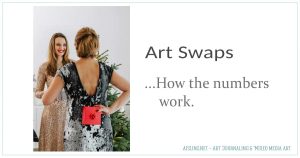 Today, I’m starting the 24-hour zine thing. (Yes, that’s what it’s called.)
Today, I’m starting the 24-hour zine thing. (Yes, that’s what it’s called.)
This may be quite a challenge!
What is a 24-hour zine?
If you’re not familiar with it, here’s the basic idea: Go from concept to completed/printed-and-bound 24-page zine in 24 hours.
My general plan is to start it around 1 p.m. today. I’m allowed to gather materials but not actually think about what’ll go in it (or prepare anything for it) until the 24 hours begin.
Last night, cutting advertisements out of some 1951 newspapers, I decided that some of them will go into this zine… I’m just not sure how, or what the theme will be, or… well, anything.
I know that it’ll be a half-page zine design. (That is, the zine is printed on 8 1/2″ x 11″ paper, and folded in half. Pages are 8 1/2″ x 5 1/2″.)
Other than that, I have no idea what I’m doing. Generally, I’d like my zine to relate to creativity, but how that fits with the 1951 newspaper ads (or if they’ll even end up in the finished zine), I don’t know.
I’m going to try to update my progress here, hourly. I’m not sure if that’s a good idea or not, and it may fall apart altogether after the first couple of entries. (The hourly posting that is… not the zine, I hope.)
Either way, that’s what’s ahead for this sunny July day in NH!
————————-
Hour-by-Hour Zine Notes
Tuesday
3 p.m. update: I’ve been working on the zine for about an hour. It’s turning into a personal zine, filled with random thoughts. Contrary to my general plans, it’s not an art zine. Oh well.
I started around 2 p.m. and I’m in the middle of a mini-collage for one page. I’ve written and printed pages 1 and 24.
The TV series, Torchwood, is on in the background, and one episode inspired the name of this zine, The Electro. Now… back to work!
4 p.m. update: I thought I’d be back in the living room, working on collages and artwork. Instead, I wrote three pages of text and created captions for two more pages. So, that’s 7 pages of 24. I’m reluctant to say, “Oh, this isn’t going to be so difficult,” because that’s the fastest route to hitting writer’s block or something…!
Now, I’m doing some pasteup before working on collages and other art for the zine. So far, so good.
5 p.m. update: I was doing well until about 15 minutes ago, when it turned out to be the sad Torchwood episode that concludes the Grey story line.
See, there have been things this year that I haven’t had time to process or mourn… other things had to keep moving forward. My mom (and my cat) would want it that way, and I knew that. Last weekend, I think we concluded the major must-do projects. Whew!
I’ve known that I’d need to grieve at some point. I’m not sure if today is that day. If it is, this zine project goes “on hold” and I start all over again, later this week. (Cheerful stuff, this… eh?)
6 p.m. update: Serendipity! The next show on BBC-America was the Charles Dickens episode of Dr. Who. The opening always makes me laugh, even in this context. (Yes, I do have a weird sense of humor…) So, I lost a little time but I’m back on track with this zine. Well, more or less.
I spent most of the last hour more thoroughly combing the 1951 newspapers for ads to include. I found several that will work, including some that will bridge between the 1951-related content and the zine pages that are from and about 2009 and beyond.
7 p.m. update: I’ve completed text & layouts for another six pages, I think. I’m trying not to wander into the too-easy trap of rosy nostalgia and idealizing an era that had plenty of problems. But… where am I going with this, anyway? I’m not sure, and that’s beginning to show.
I’m nearly ready to segue into modern collages and commentary. However, I can also see the merit of an early bedtime, so I can be up at 4 or 5 in the morning, to get a fresh start on the remaining pages.
8 p.m. update: I’m about halfway through the zine now. The basic layout is complete, and I’m finishing the cover right now. Well… I think I am.
Most of the remaining pages will be collages. Due to rapidly increasing humidity (my fingers are starting to stick to the keys on my keyboard), I should probably complete as many of them as I can, tonight. Otherwise the adhesive (gel medium) may not dry in time… the zine pages might stick to the glass on the photocopier.
The good news is, Warehouse 13 is on. There’s something ironic about how much I’m questioning the value of TV (contrasting 2010 lifestyles with those of 1951) as I’m avidly watching favorite TV shows.
9 p.m. update: My cat wants me to go to bed. (He’s the hall monitor, in a way: Schedules must be kept. Order must be maintained.) I’m seriously considering quitting for the night. However, I have just nine pages left to complete. That’s better than I expected, at this point in the day. Is it quality work? I’m not so sure. I’m too tired to tell.
I’m going to try some collages. If they don’t work out — and they might not, since the light is awful — I’m calling it a day. (Note to self: Get an Ott light.)
9:30 p.m. update: One and a half collages later… I’m tired. The light is too dim. I’m not fresh enough to create anything except minimalist, stark collages, and that’s not what I want for this zine.
So, assuming I’m asleep by 10, I can be up at 6 and working on this zine again.
————
Wednesday
6:30 a.m. update: After a semi-sleepless night, I’ve been at the keyboard for half an hour, catching up on necessary, business-related emails. I’m hoping to ignore email for the rest of the morning, and complete this zine.
I’ve also decided to include this diary (well, most of it) in the actual zine. For some reason, that makes sense to me.
I’m looking at the stack of 1951 ads I’d cut out before starting this zine — ads I decided not to use, in favor of others I selected after beginning it — and that seems right as well.
The air is still cool. The light is good. Back to work!
9:00 a.m. update: Several more collages completed, and now I’m re-checking my emails (bad habit… bad!) and pasting everything up, to see what remains empty. I know I’ve nearly completed this.
Biggest shock while making these collages: The number of “buy this” messages throughout magazines. Almost all the overt and covert messages — especially all the “look like a celebrity” ones — came from just one issue of one magazine. That’s disturbing. I mean, with that many cues and subliminal messages, most people will succumb to at least some status cravings.
10:00 a.m. update: The more I delve into this zine and lifestyle issues, the more questions I’m discovering. They’re questions I won’t have time to research or ponder within this 24-hour timeframe.
However, the zine is nearly completed now. I expect to be at the copy shop within an hour, so this will be my last hour-by-hour update about building this zine.
Thoughts at the Conclusion
I’m thoroughly dissatisfied with this zine. Yes, it represents a process. Yes, it was my first time attempting this. It still seems like a half-baked zine with no clear statement about… anything.
It also doesn’t really represent the glimmer of inspiration that occurred when I chose the zine title. I’m not sure what to do about that.
My biggest mistake was the scheduling. Mornings are my most productive time, but I started this on a hot summer afternoon, when I was tired. Nothing cohesive seemed to emerge, yet the integrity of this project/challenge requires me to publish it, as-is.
That said… I feel as if I want to redeem myself by doing a second zine this week. I’d work on it the right way, based on what I learned from this experience. I mean, do I really want to live with this as my only 24-hour zine for the 2010 challenge?
I’ll see how I feel when I see this printed. I may look at it and decide that it’s not so bad, after all.
Post-printing thoughts about the 24-hour zine
The first thing that I did was to print and bind a copy at Staples. (It’s the nearest business supply shop with a self-service copy center.) It’s not the best printing or stapling job in the universe, but it met the requirements.
I completed the zine in 24 hours. That’s what matters. (Actually, I did it in a little under 22 hours, and had a page left over — a 25th page — when I assembled the whole thing.)
After that, I went back to the copy machine and tried some different settings. The photocopied collages look much better at lighter settings. When I’m creating the zine copies that will actually go in the mail, I’m using those settings.
(I don’t have to mail a copy today… just have a finished copy; those are the rules. A copy must be mailed to the 24-Hour Zine Thing organizers in the next two weeks or so.)
Then, I sat down to lunch, followed by two big bowls of ice cream, a shower, a short nap… and I looked at the zine again. I can see some “oops” mistakes, but nothing awful.
In fact, confirming my good friend Stephen’s comments, this zine does look better after some rest.
Oh, I’m still not entirely pleased with the zine; it’s not something I’d send out to my readers, as-is, and pretend that it’s a great zine.
However, it is an authentic zine, and it’s representative of a 24-hour marathon, including my first-time mistakes.
I’m on the fence about a second 24-hour zine. As Scarlett O’Hara said, I’ll think about it tomorrow.
UPDATE: You can download this zine at the 24-Hour Zine Thing Zine – Download page.
—————————
To learn more about zines, click on the Zines tag at this site.
More info about this challenge (which seems to have ceased in 2015 or so): 24 Hour Zine Thing
 When I create anything artistic, I feel good. I’ve also noticed that my life goes better… I attract more good things into my life.
When I create anything artistic, I feel good. I’ve also noticed that my life goes better… I attract more good things into my life.
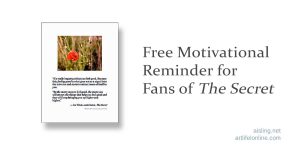

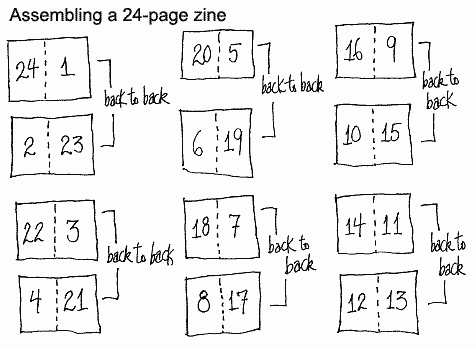


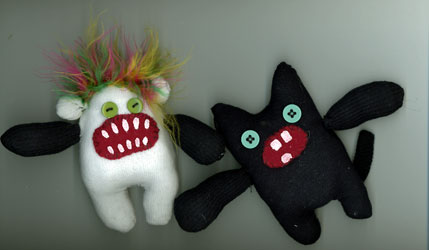


 Concluding yesterday’s
Concluding yesterday’s 
 Today, I’m starting the 24-hour zine thing. (Yes, that’s what it’s called.)
Today, I’m starting the 24-hour zine thing. (Yes, that’s what it’s called.) Some swaps say, “Documentation will be provided,” or something like that.
Some swaps say, “Documentation will be provided,” or something like that.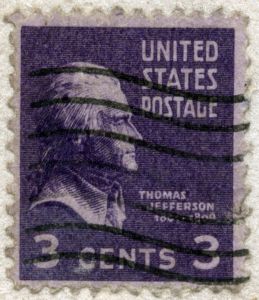 When organizing an art swap of any kind, postage can be a Very Big Headache. Here are some tips to keep the postage problems to a minimum.
When organizing an art swap of any kind, postage can be a Very Big Headache. Here are some tips to keep the postage problems to a minimum. DELIVERY CONFIRMATION
DELIVERY CONFIRMATION